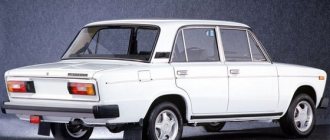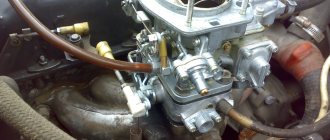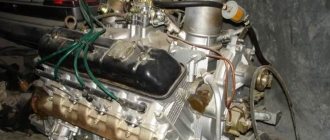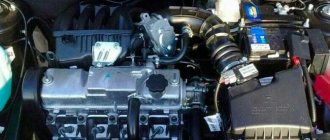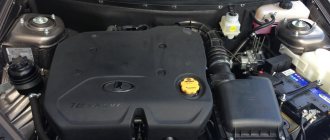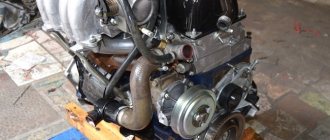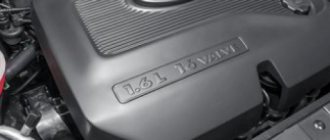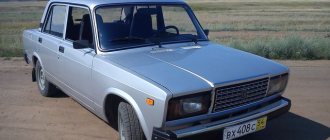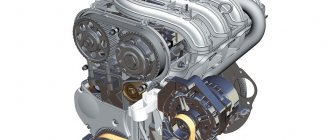ZMZ-53 is a gasoline V8, serially installed on the GAZ-53 family of cars produced in the period 1961-1993. This cargo line belongs to the third generation of medium-duty trucks of the GAZ family, which includes the GAZ-53F, GAZ-53A and GAZ-53-12 models. The GAZ-53 model was considered the most popular truck in the USSR. Its production volume exceeded 4 million copies.
Based on GAZ-53 in the period 1964-1992. They also produced a hybrid version of the GAZ-52 with a six-cylinder engine from the GAZ-51, as well as a greater load capacity than the regular 53rd model. According to the body layout in the style of a “sneaky look”, the GAZ-53 evokes similarities with the ZIL-130.
GAZ 53 engine oil
ZMZ-53 is a gasoline V8, serially installed on the GAZ-53 family of cars produced in the period 1961-1993.
This cargo line belongs to the third generation of medium-duty trucks of the GAZ family, which includes the GAZ-53F, GAZ-53A and GAZ-53-12 models. The GAZ-53 model was considered the most popular truck in the USSR. Its production volume exceeded 4 million copies. Based on GAZ-53 in the period 1964-1992. They also produced a hybrid version of the GAZ-52 with a six-cylinder engine from the GAZ-51, as well as a greater load capacity than the regular 53rd model. According to the body layout in the style of a “sneaky look”, the GAZ-53 evokes similarities with the ZIL-130.
Correct engine maintenance
The engine itself is not bad, and does not cause any complaints, the main thing is to maintain its technical condition.
This is what the internal combustion engine looks like for a GAZ 53 car
When carrying out maintenance, the cylinder head must be tightened.
But these are the first three technical inspections, later the frequency can be increased, and the cylinder head can be tightened through each TO-2.
Don't forget about the temperature.
To make the engine last longer, replace the piston rings as soon as necessary. The car itself will tell you that it’s time to replace the piston rings. In this case, after every 100 km. mileage the oil will decrease by approximately 400 g. If the oil pressure in the system has dropped, then the problem is in the crankshaft main bearing shells, which also need to be changed immediately.
Engine for GAZ 53 in section
How much oil to pour into the engine of a GAZ 53 car
First generation 1961-1993
The ZMZ-53 engine has eight cylinders and a displacement of 4.25 liters, while its predecessor ZMZ-41 had a volume of 5.53 liters. The piston diameter is 92 mm versus 100 mm for the ZMZ-41, and the piston stroke is 80 mm (88 for its predecessor). The piston ring diameter is 25 mm (+3 mm). In addition, the new internal combustion engine model received a different cylinder block, crankshaft and cylinder head.
Thus, an aluminum block made it possible to reduce the weight of the structure and two cylinder heads, also made of winged metal. At the same time, the reliability of the motor has increased, and it has become easier and cheaper to maintain. The engine develops 115 horsepower, and the compression ratio is 6.7, like the ZMZ-41.
- 3.48 liters 82 l. With. (GAZ-51), year of manufacture – 1961-1967, oil volume – 7 liters, tolerance and viscosity: API-SG; SAE 10W-30, 15W-40, 5W-40
- 4.25 liters 115 l. With. (GAZ-53, ZMZ-53), year of manufacture. – 1965-1992, oil volume – 8 liters, tolerance and viscosity: tolerance and viscosity: API-SG; SAE 10W-30, 15W-40, 5W-40
How to measure engine oil pressure
This is a service operation. It’s hard to even imagine that a simple car owner would have a special pressure gauge at hand. Such a device will help to obtain accurate values at any speed. This will allow the diagnostician to recognize the malfunction and avoid it.
Drawing. Pressure gauge connection diagram.
Let's look at a specific example. Let's take 2 petrol versions of the Land Cruiser Prado 150. The lubrication pressure of these cars is measured at 3000 rpm. But the standards for engines differ. So for a gasoline 2.7 it corresponds to the range of 1.6-5 atmospheres, and for a 4-liter: already 3-6 atmospheres. As you can see, even for the same manufacturer the numbers vary greatly. What will happen then if we are talking about Volkswagen, Skoda, BMW, Mercedes?
What kind of oil should be poured into the GAZ 53 engine
Original
For the GAZ 53 car, AC-8 automobile oil is recommended. You should fill in mineral (10W-30, 15W-40) or semi-synthetic (10W-40) fluid produced by Lukoil, Gazpromneft, etc. In severe frosts, synthetic all-season oil 5W-40 is allowed, however, for the ZMZ-53 V8 engine, mineral water or semi-synthetic.
Unoriginal
The following oils are poured into the GAZ-53 car engine:
- Lukoil Lux 5W-40 API SL-CF semi-synthetics
- Gazpromneft Premium 5W-40 API SM/CF
- Tatneft 5W-40 synthetic.
Require topping up
Let us recall a joke from the 90s. A huge SUV has been sitting at the gas station for an hour. Fuel is poured into it, but the tank is not filled. The gas station attendant turns to the driver: “Perhaps you could turn off the engine?” In general, the gluttony of transport at today's gasoline prices has become a headache even for wealthy car owners.
On average, the price of AI-92 has increased by more than 6 percent since the beginning of May, and now this fuel costs almost 42 rubles per liter. And in some places the price reaches 45 rubles per liter of not the most environmentally friendly fuel. That is why interest in gas has almost doubled.
Let us recall that back in May 2013, the Russian government issued a decree “On regulating relations in the field of using gas motor fuel, including natural gas as a motor fuel.” According to it, at least half of Russian public transport will be switched to gas fuel. The planned amount of funding for the program until 2022 will be 110 billion rubles from the federal budget. However, before the May rise in gasoline prices, the issue of switching to natural gas motor fuel was not so relevant for private Russian car owners.
Along with rising prices for traditional fuel, a new problem has arisen. There are scams at many gas stations. That is, pour into the tank as much as will not fit there by definition. If the volume of fuel poured actually exceeds the technical capabilities of the car, this is not difficult to prove. Not a single gas station will enter into conflict. But if the driver simply knows that he can’t fit in so much, then this is not proof.
With gas, such fraud is practically impossible.
Reviews
Georgy, Petrozavodsk. It doesn’t matter at all how old this workhorse is. Simplicity, reliability, cross-country ability and ease of maintenance - these are the main advantages of the GAZ-53, which are necessary in work. The disadvantages include gluttony, lack of comfort and a stiff suspension, but with adequate maintenance the GAZ-53 will still serve me. I work on it in the countryside, and that’s where this bucket belongs.
Nikolai. In the late 80s I had the opportunity to work in a cooperative on a GAZ-53. Mostly positive memories remained from it, despite the cramped and spartan two-seater cabin, with poor visibility and mediocre ergonomics. Shaky suspension, fuel consumption of 25 liters, low-quality metal - in general, you can list as many as you like. However, in rural areas, the GAZ-53 seemed to be rehabilitated due to its high cross-country ability. And now it can be recommended for a start-up business or just lovers of the domestic automobile industry. In caring hands it will last as long as necessary.
Source
GAZ 53 3309 SAZ D-245 › Logbook › Changing the oil and cleaning the centrifuge D-245
Changing the engine oil is a necessary procedure and I’ve already done it, but I neglected cleaning the centrifuge for the first time
, and it won’t clog too much. How long does it take?
Moreover, the guy from whom I bought it didn’t pay attention to the appearance,
but technically everything was in decent condition.
And here, at the beginning of the summer season, I decided to do it the right way
.
I didn’t know how to do it in detail. I warmed up the oil and drained everything according to the standard
.
Unscrewed the centrifuge cap.
At the bottom I blocked the rod with a screwdriver from above with a 36 wrench; I didn’t find anything like that and took an adjustable one.
Gadget has gone. Twisted and twisted
.
Time to remove the glass
. And this picture appeared before my eyes.
At first I didn’t understand the filter as a filter, the edges are perfectly smooth and clean or something?
And then it came... Pure fuel oil
.
How long hasn't it been cleaned?
How the poor fellow the engine even worked and there was pressure .
And here I showed irresponsibility by not immediately cleaning everything as it should be. The scraping process has begun, the layer is 10-15mm
.
I scraped out the bottom of the glass and found some spare parts.
I moved on to the mesh, which turned out to be torn, well, not surprising with such a layer of dirt. I bought a new one.
I forgot how it all stood
I figured out the options for expanding the mesh up into it with a knife and a washer on top.
Twisted and assembled.
So far I have filled the oil with Oilright M10DM.
I thought my blood pressure would rise
,
but no, he still keeps the unit hot. And the moral of this fable is that no matter who you buy from, you need to redo and double-check it yourself. If only I could get to the pallet, I don’t think the picture there is very cheerful either. Thanks to everyone who read!
And here’s a question: advise who drives what or who has any experience or preferences regarding oil? Issue price: 1,000 ₽
see also
Comments 27
I usually flush the system with this oil. During operation on cars, and the Gazelle stopped at the Avangard, I will also pour it into the GAZon - it washes well, lubricates well, no signs of turning into fuel oil were found.
Was it dirty, has it become cleaner, or does it leave nothing behind?
It washes when the dirt is not on the walls in the form of deposits, but in the pan in the oil.
So the oil poured in front of the vanguard, say, under the valve cover, left traces of its presence and Lukoil corrected it? The opinion that if the oil quickly turns black means it washes is not entirely correct, a shaky engine can itself quickly dirty the oil
No not like this. Wash the engine, for example during disassembly or partial disassembly. Then fill it with fresh oil and drive away. After some time, we open the valve cover, for example (before the first replacement or after a couple of replacements) and look at the walls, they should not be covered in deposits. If the oil has not darkened after changing and running 5-6 thousand, I think it’s not oil, but bullshit. Because the design of the internal combustion engine is such that wear of the mechanical parts is always present. The oil flows into the pan and should wash away these wear products. Whatever the filter, it cannot, with the wave of a magic wand, lift everything from the pan and filter it. At its core, the sump is a sump. Clean oil with high mileage is a reason to think about the quality of the oil.
Yes, the oil is rubbish, I also pour myself LUKOIL Avant-Garde, both in KAMAZ and in Zila
I won’t argue, I filled it up for a temporary period so as not to drive on last year’s car while I’m working on the car, driving according to my needs, the mileage is insignificant without winter, I’ll eliminate the snotty, I’ll fill it with decent oil
But don’t you want to get rid of the centrifuge? on new tractors and machines there is a screw-on filter, you change the oil, unscrew it and install a new one, you just need to buy an oil filter housing and install it instead of a centrifuge and that’s all, well, that’s just advice))
We’re sitting at the table, everyone has already given in, and then one guy wants to clink glasses with another guy sitting on the other side, they grab a shot glass from the middle of the table, clink it with the one further away and return it, a friend next to him has five-ruble eyes rolling out with the words “why was that possible?” It is necessary to study the question of the feasibility of finding out what cleans better; from a financial point of view, a centrifuge is of course more economical
Engine oil for GAZ 3309
For diesel engines with volumes of 4.75 and 4.43 liters, it is necessary to use about 12 liters of lubricant. It is recommended to use liquids on a mineral or semi-synthetic basis as fillers. The viscosity level is 15w40, 5w40, 10w40. Replacement frequency is upon reaching 7,000-10,000 km.
If there is a desire or need to replace factory oil with identical analogues, then you can use any mineral compositions. Experienced car enthusiasts recommend using motor lubricants from the following manufacturers:
- Lukoil;
- Gazpromneft;
- Castrol;
- TNC;
- Shell.
The main thing is not to forget that the product must correspond to the level of viscosity depending on the operation of the car for certain weather conditions.
The design of a car engine for GAZ-53
The main advantage of the GAZ-53 engine is its efficiency and decent technical potential.
- The base of the GAZ-53 gasoline engine is a simple carburetor with a “V” shaped installation of cylinders. This arrangement increases engine power and torque.
- The next distinguishing feature is the screw exhaust valve and high turbulence chamber in the cylinder heads, which improves efficiency.
- The presence of an exhaust gas recirculation system, which reduces the amount of emissions into the atmosphere.
- Carter.
- Gear box.
- Combined lubrication system.
- The liquid-based cooling system ensures smooth operation even in hot weather.
New engine for GAZ 53A
In 1964, the Zavolzhsky Motor Plant, based on the ZMZ 41 engine, developed a new engine that was equipped with the GAZ 53. It should be noted that six-cylinder internal combustion engines were no longer installed on the second generation of “lawns” (GAZ 53A), and in the future only “fifty-thirds” were equipped with V-shaped 8-cylinder engines.
The new internal combustion engine received the ZMZ index 53A. Just like the ZMZ 13, the engine received an aluminum block and two cylinder heads (cylinder heads) made of the same metal. The ZMZ 53A had a number of clear advantages over the outdated six-cylinder internal combustion engine:
- The engine weighed less;
- It had more power and cylinder capacity;
- Fails less often;
- It was more convenient to repair and maintain.
Description of the motor device
The engine of the ZMZ 53 model has become compact. And throughout the years when the engine was produced, the cross-section of the combustion chamber, stroke and diameter of the pistons remained the same. And the V-shaped arrangement of the cylinders allows the engine to increase torque and make the engine more powerful.
In the design of the Gas 53 modification engine, in the first years of production, the manufacturer used K126B carburetors. These elements had two chambers. And a mesh filter device was placed in front of the carburetor. Thanks to this, environmental standards were observed.
The design of the Gas cylinder engine also includes:
- Lubrication system;
- cooling system.
Recently, engineers have been installing updated cylinder heads. The valves were placed at the top of the engine. All this contributed to improving the technical parameters of the Gas 53 engine.
The operating order of the cylinders was the following combination: 1-5-4-2-6-3-7-8. Engineers installed a combined lubrication system. The oil is supplied with pressure and sprayed. Thus, the wear of the motor and its parts during operation was reduced.
Attention! The oil is purified using a centrifuge. The pressure is obtained through a pump, which is driven by gears.
The lubricant in the radiator is cooled. Circulation passes through all vehicle systems. Therefore, the car can drive equally well in both cold and hot weather. The engine does not overheat and starts easily in harsh winters.
There are several types of engine models. However, the design did not undergo major changes in any new model.
There were other modifications as well. However, they had only an experimental type of development. Never used in mass-produced vehicles.
From the history
From the fall of 1961 to January 1967, Gorky produced the GAZ 53 with the index “F”; the GAZ 53F was powered by the six-cylinder GAZ 51 engine. Although the engine was somewhat improved at that time, it had significant drawbacks.
The internal combustion engine was already obsolete by that time. The lower arrangement of the valves gave low efficiency and low power; the engine was inconvenient to maintain and repair. Even adjusting the valves was a problem, and it took a lot of time to adjust them. The cast iron structure had considerable weight, the motor had a relatively short mileage. Everything was moving towards replacing the outdated design with something more acceptable.
Example of an engine for GAZ 53
In April 1958, in the city of Zavolzhye, Gorky Region, a new engine plant began producing engines and spare parts for them. ZMZ was a subsidiary of GAZ and made engines for this enterprise. In parallel, internal combustion engines were produced for the Ulyanovsk and Moscow Automobile Plants.
At the end of 1958, the Trans-Volga enterprise mastered the casting of aluminum alloys, and the plant began to develop the production of new light metal parts.
At the time, this was a big step forward in the automobile industry.
First, ZMZ designed a V-shaped 8-cylinder engine for the GAZ 13 “Chaika” (ZMZ 13). The engine had a power of 195 horsepower and ran on high octane gasoline (Ai-93 or Ai-95). Almost immediately, the ZMZ 41 internal combustion engine (140 hp) was developed. ZMZ 41 ran on “seventy-sixth” gasoline. This engine was installed on the Volgas of the special services.
This is what a V-shaped 8-cylinder internal combustion engine looks like
This is interesting: How much oil is in a Nissan Terrano engine
Technical parameters of ZMZ-53
The ZMZ-53 four-stroke gasoline carburetor power unit has been installed on the GAZ-53 since the late 70s.
Main technical characteristics of ZMZ-53:
- cylinders – 8 pcs.;
- maximum torque – 30 kg*force/m;
- engine capacity – 4.25 l, with minimum power – 125 l. With.;
- compression ratio – 7,6;
- minimum speed registers A-76 gasoline consumption - 210 g. at one o'clock;
- engine weight – 260 kg.
Characteristics of ZMZ 53A
Starting from 1966, the ZMZ 53 engine was installed as standard on GAZ 53A and GAZ 53 12 vehicles. It had an overhead valve arrangement, and the model used a K 126B carburetor. Later a different carburetor was installed (K 135)
Unlike the ZMZ 41, the 53rd engine has a smaller cylinder volume and piston stroke. Some people claim that the parts of these internal combustion engines are interchangeable, but this is absolutely not true. The engines even have different cylinder blocks, not to mention the piston group, crankshaft and cylinder head. The difference in the blocks is that the seats for the cylinder liners are of different diameters, so replacing one block with another will be extremely problematic.
Technical characteristics of ZMZ 53A:
- Engine volume is 4.25 l (ZMZ 41 has 5.53 l);
- Piston diameter 92 mm (for ZMZ 41 - 100 mm);
- The piston stroke is 80 mm (for ZMZ it is 41 - 88 mm);
- The diameter of the piston pin is 25 mm (for ZMZ it is 41 - 28 mm);
- Engine power 115 hp (ZMZ has 41 - 140 hp);
- The compression ratio is 6.7 (ZMZ 41 has 6.7).
Required Engine Maintenance
GAZ-53 engines have good endurance and a long service life. To extend its service life, it is recommended to carry out its maintenance. Timely measures will save money and time.
- Regular change of engine oil - every 6 thousand km traveled. The most suitable oil would be mineral-based or semi-synthetic.
- Periodically (every 1–2 thousand km) the cylinder head is tightened, as well as the spider intake manifold is attached.
- Adjust the valves after replacing the cylinder head gaskets or when tapping.
- When changing cylinder head gaskets or performing scheduled engine repairs, you should immediately tighten the bolts and belts on a cooled GAZ-53 engine. During the period outside of repairs, the condition of the belts is checked after 30 thousand km.
- In the summer, check daily that there is enough coolant in the system, as well as water, to avoid engine overheating.
- Monitor the oil level and the serviceability of the sensors on the dashboard. This should be done by the owners of Volga and UAZ. If there is insufficient oil in the GAZ-53 engine, top it up to avoid repairs.
- External inspection for oil leaks, which is the main possible engine breakdown.
All breakdowns should be repaired immediately as they occur. Disassembly of the GAZ-53 engine is carried out with special tools and experienced employees in the workshop.
gas enters the oil. what could cause this?
fuel fractions
Instead of having two SEPARATE tanks for gas and oil, Poulan chainsaws have one tank, which requires a gas-oil consistency. Poulan chainsaws work best with a gas-oil ratio of 40 parts gas to 1 part oil. Mix carefully. The chainsaw is filled with a very large amount of gas; it can overheat or fail. In the same way, a chainsaw with a very large amount of oil in the fuel mixture may work sluggishly.
If you are not in the original situation and continue testing; the injectors will continue to supply fuel to the cylinders, even if the car does not start. (You get gas getting into the oil)
Last but very important
Correct all fuel related defect codes and change the oil; Before starting your engine.
This means that the gas is somehow getting into your engine oil.
However, it is common for small amounts of gas to enter your oil during normal engine operation.
Gas infiltration into oil becomes a cause for concern when gas volume exceeds 2.5 percent. If a huge amount of gasoline gets into the engine oil; Change the oil immediately after eliminating the problem that allowed this to happen.
Gas entering the oil
This leads to a significant decrease in oil viscosity, which affects engine lubrication and causes the formation of deposits on the cylinder walls along with bearing failure.
https://avtovalik.ru/raznoe/gaz-53-kakoe-maslo-zalivat-v-dvigatel.html
Possible breakdowns of ZMZ-53
Among the most common malfunctions of the ZMZ-53 engine, the following should be noted:
- Increased fuel consumption. The cause may be an oil leak through the seals or other connections.
- Burnout of engine oil seals occurs due to overheating of the unit.
- The knocking of the connecting rod bearing occurs due to a decrease in the oil level, pressure in the system and wear of spare parts.
- Tapping of the upper bushing and the stroke of the piston means a crack in the skirt and partition of the piston ring, burnout of the bottom.
- The exhaust valve is burnt out - this is due to low-quality fuel, as well as oil getting on the valve and narrowing the gap in the valve.
Replacing piston rings
The main sign that it is time to change the piston rings is an increase in lubricant consumption. Normally it is 400 g per 100 kilometers. The piston ring set includes steel discs and a cast iron compression ring.
During replacement, the unworn section of the belt is removed from the cylinder liners, and the cylinder head is cleaned of carbon deposits.
The gas distribution mechanism also requires regular diagnostics. Valve clearances are checked only with the engine idling and the pusher lowered all the way.
This is interesting: What kind of gasoline does the Chevrolet Niva run on?
Disadvantages of breakdowns and problems of the GAZ 53 engine
In a Gas 53 internal combustion engine, the lubrication system sometimes malfunctions. The pressure drops. The car owner pays attention to this when it is already too late. The engine overheats and parts become deformed.
To avoid such problems, you need to go to a service center once a year, where first aid will be provided to the car. All components were checked, new parts were installed to replace those that were worn out.
A common problem with Gas 53 is deformation of the intake manifold. Also followed by a grease leak from the rear main bearing. This results in increased lubricant consumption.
If the vehicle is operated under high loads, scuffing may occur on the crankshaft journals.
Due to overheating, all gaskets on the engine often burn out. They also need to be changed annually. From time to time the exhaust valve burns out. This means that low-quality fuel is used.
Many car owners try to tune the engine. Tuning consists of installing a new ZMZ 53 diesel engine, for example, from a Volga vehicle. The advantages of the latter are as follows:
- eats little fuel;
- life resource exceeds 400 thousand kilometers;
- easy to replace air filter, oil and fuel filter devices;
- high efficiency.
You can even carry out the shift in a regular garage. To do this, you will need to remove the old engine, rebuild the fasteners on the ramp, and change the fuel tank. New electrical wiring is then installed, adapters are constructed, and the driveshaft is rebuilt.
Similar article 3S-FE engine: characteristics and which cars it was installed on
They also tighten the intake manifold. Typically, experienced mechanics carry out the tightening procedure after a run of 2 thousand kilometers. This is a prerequisite for older power units.
Motor lubricant is changed after 6 thousand kilometers. Valve adjustment is done after replacing the cylinder head. The engine oil level is monitored. If necessary, add more.
If you do not pay attention to the engine malfunction in time and do not replace the necessary part, then the car owner has a high chance of losing the power unit. And the engine is put in for major overhaul after 250,000 kilometers.
Also pay special attention to the coolant level. This is especially true during summer periods. Any decrease in fluid in the system leads to overheating of the engine. This means that all rubber gaskets will burn out faster than at normal coolant levels.
To take a compression test, you will need a partner. And also do not forget to purchase a special device - a compression meter. To carry out the procedure, unscrew the candles completely. Open the throttle valve and disconnect the battery.
Attention! The optimal compression is considered to be 7.5 kg per cm².
Consequences of using diesel oil in a gasoline engine
Therefore, taking into account the properties of diesel oil and engine operating conditions, there may be two developments in the use of such a lubricant in a gasoline engine.
1st case
Using oil in a gasoline engine of a light truck, such as a GAZelle, which operates at low speeds and the oil change schedule is not always followed, can help remove carbon deposits
. Because the best composition for pre-washing an engine is one that contains a lot of calcium additives and a high alkalinity index. On the Internet you will find more than one story about how hydraulics stop knocking, the engine becomes quieter, and it cleans better.
That is, diesel oil is often used as a long-term flush. After all, since the cleaning properties of such oil are 2 times higher, provided that the engine does not spin above 4000 rpm, deposits
that formed earlier
become softer
.
And then when washing the inside of the engine during disassembly, it is easier to remove
.
However, it is worth considering that heavily contaminated engines can cause harm, since the dirt will flow in large pieces through the oil channels and, if they are thin, can clog them. This may cause the engine to simply seize.
!
2nd case
As I said above, diesel oil does not like high speeds! Accordingly, the use of such oil in a modern engine
, where low ash content is required, and the oil is susceptible to high temperatures, leads to the fact that the inside of the engine, on the contrary, will be covered with resinous soot, and the pistons and all oil channels will
quickly become coked
!
By the way, to make this process more understandable, look at the article: “
Why do the piston rings of modern engines lie down quickly .”
Tuning options
In order to give a more attractive look and improve the performance of the GAZ-53 engine, the following types of tuning are practiced:
- A complete replacement of the engine involves the installation of a diesel, more powerful engine. At the same time, fuel consumption is reduced and the service life is increased to 400 thousand km. And also servicing the motor will not be difficult.
- The fasteners are welded, the fuel tank, electrical wiring, exhaust system are changed, and the driveshaft is remade.
- Updating the cabin on a GAZ-53 car involves installing a central locking and alarm system.
- Replacement of the rear axle from GAZ-3307. This is characterized by a particularly robust suspension and a self-locking rear axle.
- Transmission upgrade - it is recommended to replace the gearbox from the GAZ-3309.
Gearbox oil
All lubricants used in transmissions and engines consist of a main component, as well as various additives. When the engine is running, its temperature increases. At the same time, the oil begins to foam and, of course, loses its lubricating properties. In order to prevent the properties of oils from deteriorating, special additives are added to their chemical composition, which correct and improve the performance characteristics of the lubricant.
In our online store you can purchase gearboxes for GAZ vehicles of various brands. For any questions, please contact our sales consultants.
In addition to lubricating the rotating gears, oil also acts as a heat remover from rubbing parts. When the car drives, the oil in the gearbox heats up to 150 °C. At the same time, in the places where the gears engage, the temperature reaches 300 °C. At this temperature, the lubricant foams and begins to perform its functions worse.
In cars with automatic transmission, oil transmits engine torque to gears. Therefore, when the lubricant foams and completely loses its viscosity, the car is simply unable to move. Practice has shown that additional radiators that cool the oil are ineffective here. Adding special additives to the lubricant is the best solution to this problem.
What cars was the power unit installed on?
Motors were installed on cars from the Gas company (Gorky Automobile Plant). These were trucks that were equipped with tanks for various liquids. The engine was installed on vacuum trucks, van trucks, and fire trucks. Some UAZ models are also equipped with ZMZ 53 engines.
Similar article Technical characteristics of the 3S GE BEAMS engine
The cars were made with absolutely no comfort for the driver and passenger. The seats were made hard and power steering was not installed. Cabins in old cars are not heated in winter.
Recently, many car enthusiasts have been trying to modernize not only the engine, but also the car. I must say that they achieve a good effect.
But, despite the advantages of the engines of that time, they also had disadvantages. I'll tell you about them in the next block.
GAZ 53 3309 SAZ D-245 › Logbook › Changing the oil and cleaning the centrifuge D-245
Changing the engine oil is a necessary procedure
and I’ve already done it, but I neglected cleaning the centrifuge for the first time
, and it won’t clog too much. How long does it take?
Moreover, the guy from whom I bought it didn’t pay attention to the appearance,
but technically everything was in decent condition.
And here, at the beginning of the summer season, I decided to do it the right way
.
I didn’t know how to do it in detail. I warmed up the oil and drained everything according to the standard
.
Unscrewed the centrifuge cap.
At the bottom I blocked the rod with a screwdriver from above with a 36 wrench; I didn’t find anything like that and took an adjustable one.
Gadget has gone. Twisted and twisted
.
Time to remove the glass
. And this picture appeared before my eyes.
At first I didn’t understand the filter as a filter, the edges are perfectly smooth and clean or something?
And then it came... Pure fuel oil
.
How long hasn't it been cleaned?
How the poor fellow the engine even worked and there was pressure .
And here I showed irresponsibility by not immediately cleaning everything as it should be. The scraping process has begun, the layer is 10-15mm
.
I scraped out the bottom of the glass and found some spare parts.
I moved on to the mesh, which turned out to be torn, well, not surprising with such a layer of dirt. I bought a new one.
I forgot how it all stood
I figured out the options for expanding the mesh up into it with a knife and a washer on top.
Twisted and assembled.
So far I have filled the oil with Oilright M10DM.
I thought my blood pressure would rise
,
but no, he still keeps the unit hot. And the moral of this fable is that no matter who you buy from, you need to redo and double-check it yourself. If only I could get to the pallet, I don’t think the picture there is very cheerful either. Thanks to everyone who read!
And here’s a question: advise who drives what or who has any experience or preferences regarding oil? Issue price: 1,000 ₽
Modifications
The variety of modifications of the GAZ-53 engine does not differ; the basis is the ZMZ-53 with some improvement in operating life and service. Some types of engine modifications can be distinguished:
| Type | Piston stroke, mm | Piston diameter, mm | Power, l. With. | Engine capacity, l |
| ZMZ-6606 | 92 | 80 | 120 | 4,25 |
| ZMZ-511 | 92 | 80 | 125 | 4,25 |
| ZMZ-523 | 92 | 88 | 130 | 4,68 |
Engine Specifications
Below are the technical characteristics of the ZMZ 511.1000398 engine for GAZ-53 GAZ-3307 and AI-76
The engine is carburetor, gasoline, with a V-shaped arrangement of cylinders at an angle of 90 degrees and an overhead valve arrangement.
The engine uses cylinder heads with highly turbulent combustion chambers and helical intake ports. All engines use an exhaust gas recirculation system to reduce emissions of harmful substances into the atmosphere. The engines have a clutch housing for a unified gearbox.
- number of cylinders - 8;
- operating mode - 4-stroke;
- compression ratio - 7.6:1;
- working volume, l - 4.25;
- rated power at a crankshaft speed of 3200-3400 1/min, kW (hp) - 92 (125);
- maximum torque at a crankshaft speed of 2000-2500 1/min, N*m (kgf*m) - 294 (30);
- minimum specific fuel consumption g/kW*h (g/l. S.*h) - 286 (210);
- oil consumption for waste, % of fuel consumption - 0.4;
- weight, kg - 262;
- fuel - A-76.
External speed characteristics of the engine.
By complying with all requirements, the GAZ 53 engine will serve you and your children.
Description of the GAZ-3307 (3307) model
Modifications of the GAZ-3307 car:
– GAZ-330701 — version “HL” for cold climates; – export - GAZ-330706 - for countries with a temperate climate and GAZ-330707 - for countries with a tropical climate; – GAZ-33073 – cargo-passenger taxi; – GAZ-33075 and GAZ-33076 - gas cylinders, operating respectively on liquefied petroleum gas (propane-butane) and compressed natural gas; – GAZ-33072 – chassis for dump trucks; – GAZ-33074 – chassis for buses; – GAZ-3307 – chassis for specialized vehicles.
Load capacity, kg - 4500
Curb weight, kg - 3200 Including: front axle, kg - 1435 rear axle, kg - 1765
Gross weight, kg - 7850 Including: front axle, kg - 1875 rear axle, kg - 5975
Permissible trailer weight: with inertial-hydraulic brake drive, kg - 3500 not equipped with a brake system, kg - 750
Maximum vehicle speed, km/h - 90 Same, road trains, km/h - 80 Minimum sustainable speed in low gear, km/h - 5-6 Acceleration time of vehicles to 60 km/h, s - 32
Maximum surmountable incline by cars - 25% Same as by road train - 18% Run-down of cars from 50 km/h, m - 660 Braking distance of cars from 50 km/h, m - 25
Control fuel consumption of cars: l/100 km: at 60 km/h, l - 19.6 at 80 km/h, l - 26.4
Turning radius: on the outer wheel, m - 8 Overall, m - 9
Engine
Modification ZMZ-53-1 1, gasoline, V-shaped (900), 8 cylinders, 92×80 mm, 4.25 l, compression ratio - 7.6, operating order - 1-5-4-2-6 -3-7-8, power 88.5 kW (120 hp) at 3200 rpm, torque - 284.5 (29 kgf m) at 2000–2500 rpm, carburetor - K-135, air filter - inertia-oil. The installation of a pre-heater PZHB-1 2 heat with a capacity of 10,400 kcal/h (power 1-2 kW) is provided.
Transmission
The clutch is single-disk, with peripheral springs, the release drive is hydraulic. Gearbox - 4-speed, gear ratios: I - 6.55; II - 3.09; III - 1.71; IV - 1.0; ZH - 7.77. The cardan transmission consists of two shafts with an intermediate support. The main gear is a single hypoid, gear ratio is 6.17.
Wheels and tires
Wheels - disc, rim. 6.0B-20 with side rings, fastening with 6 studs. Tires - 8.25R20 (240R508) models U-2 (K-84) or K-55A, tire pressure on the front wheels - 4.5 kgf/cm2; rear - 6.3 kgf/cm2. Number of wheels - 6+1
Suspension
Dependent: front - on semi-elliptic springs with shock absorbers; rear - on semi-elliptic springs with additional springs; the ends of the main sheets of all springs are installed in rubber pads of the support brackets.
Brakes
The service brake system has drum mechanisms with a diameter of 380 mm, the width of the front linings is 80 mm, the rear linings are 100 mm, a dual-circuit hydraulic drive (separate along the axes), and a hydraulic vacuum booster. The parking brake is a transmission drum (diameter 220 mm, lining width 60 mm), with a mechanical drive. Spare brake - any of the circuits of the service brake system.
Steering
The steering mechanism is a globoidal worm with a three-ridge roller, the gear ratio is 21.3.
Electrical equipment
Voltage - 12 V battery - 6ST-75 generator - G250-G2 voltage regulator - 222.3702 starter - 230-A1 ignition coil - B114-B (B116) ignition switch - TK102A (13.3734 or 13.3734-01) additional resistor - SE107 (14.3729) )1 distributor (sensor-distributor) - P133-B (24.3706) spark plugs - A11-30.
Filling volumes and recommended operating materials
Fuel tank 105 l gasoline A-76; cooling system (with heater), l - 23 water or antifreeze - A40, antifreeze - A65 engine lubrication system, l - 10 all-season M-8V or M-6/10V (DV-ASZp-10V). at temperatures below −20°C oil ASZp-6 (M-4z/BV), (replacement - all-season ASZp-10) gearbox - 3.0 l. all-season TAP-1 5v. at temperatures below −25°С oil TSp-10 or TSz-9gip (replacement - all-season) TSp-15K, at temperatures below −30°С a mixture of TSp-15K with 10-15% diesel. fuel 3 or A); final drive housing - 8.2 l all-season TSp-14gip, at temperatures below −35°C TSz-9gip (replacement - at temperatures below −35°C a mixture of TSp-14gni oil with 10-15% diesel fuel 3 or A) ; steering gear housing - 0.6 l, the same as for the gearbox; shock absorbers 2×0.41 l, shock absorber fluid AZh-1 2T (substitute - spindle oil AU); hydraulic brakes and clutch releases - 1.35 and 0.25 liters, respectively, "Tom" brake fluid (substitute - "Neva"); windshield washer reservoir - 1.5 l. NIISS-4 liquid mixed with water.
Source
Motor oils and everything you need to know about motor oils. Homemade applications of GIS ZMZ 53
Due to the unpretentiousness of engines of the ZMZ 53 series, their availability and extremely low price, many “homemade” ones often try to “implement” internal combustion engines on other brands of cars. For example, similar units have already been installed on Gazelle.
Despite the rather impressive dimensions, the “Gazonov” engines have a very small weight (230-270 kg), and the engine still fits under the hood of the Gazelle, the car is not very loaded. These engines are also installed in UAZs with appropriate alterations (the radiator is changed, the engine mounts are re-welded, etc.)
An example of a homemade tractor using a ZMZ 53 motor
GAZ-53 engine lubrication system
The GAZ-53 engine lubrication system (Fig. 1) is combined: under pressure, splashing and gravity. The oil in the engine oil sump is sucked into the oil pump 9 through the oil receiver 12.
From it, oil under pressure is supplied through channels in the block to the oil filter 4 for full-flow cleaning, and from there to the main oil line 6 of the engine. From the main line of the GAZ-53 lubrication system, oil flows through channels in the cylinder block to the crankshaft main bearings and camshaft bearings.
By drilling in the crankshaft, oil from the main bearings enters the cavities of the connecting rod journals and through the drillings in the connecting rod journals to the connecting rod bearing. In the cavities of the connecting rod journals, the oil undergoes additional cleaning due to centrifugal forces.
1. oil cooler; 2. cavity of the rocker arm axis; 3. channel in the cylinder head; 4. oil filter; 5. channel in the cylinder block; 6. main oil line; 7. hole in the distributor drive housing; 8. cavity; 9. oil pump; 10. pressure reducing valve; 11. 4th camshaft neck; 12-oil receiver; 13. safety valve; 14 oil cooler valve, 15. 2nd camshaft neck
Here are the 2nd and fourth camshaft supports, oil flows through the channels in the GAZ-53 block and heads to the rocker arm axes. From the internal cavity of the rocker arm axis, oil flows through drilling to the rocker arm bearings.
Next, follow the grooves in the rocker arm bushings, drilling into the rocker arms and adjusting screws. to the top ends of the rods. Flowing down the rods, the oil flows to the lower tips and through the holes in the pusher it connects to the oil sump; we lubricate the pusher guides and their ends.
The stubborn flange of the GAZ-53 camshaft is lubricated through a flat and a hole in the front camshaft support. Drive gears through a tube from the main oil line.
The drive of the ignition distributor, the oil pump and its gears are lubricated with oil coming from cavity 8 located between the fifth support neck of the camshaft and the plug in the cylinder block. Other parts that need lubrication are supplied with oil either by splashing or by gravity.
The oil pressure in the GAZ-53 lubrication system when the car is moving in direct gear at a speed of 55 km/h should be at least 250 kPa with the oil cooler turned off and the engine warmed up thoroughly. When starting and warming up a cool engine, the oil pressure can reach 500.550 kPa.
When the oil pressure in the oil line of the GAZ-53 engine drops to 40.80 kPa, the emergency oil pressure indicator lights up on the device panel.
Let's assume that the warning light comes on at a low crankshaft speed in idle mode. If the lubrication system of the GAZ-53 engine is working properly, the warning light goes out when the rotation speed increases.
If the indicator lights up at medium and high engine speeds, it indicates a malfunction. To eliminate it, the upcoming operation of the vehicle is not allowed.
When the ambient temperature is above 20 ° C and when driving in particularly heavy conditions, you need to turn on the oil cooler by opening the tap located on the left side of the engine. When the radiator is turned on, the faucet handle is oriented along the axis of the hose.
Oil enters the radiator only when the tap is open through the safety valve. This valve opens at a pressure in the GAZ-53 lubrication system of about 100 kPa. After passing through the radiator, the oil joins the oil sump.
The oil sump of the GAZ-53 engine is made of sheet steel, stamped, and attached to the lower plane of the cylinder block with studs.
The crankcase flange is sealed with a cork gasket. At the bottom of the crankcase there is a drain plug sealed with a metal-asbestos gasket. The oil receiver is a mesh type, not a floating type.
Oil pump GAZ-53 (Fig. 2). gear type, single-section, driven by the ignition distributor drive through the intermediate roller.
The housing of the GAZ-53 oil pump is made of duralumin alloy, the cover is made of cast iron. The lid contains a pressure reducing valve that protects the lubrication system from excess pressure. The valve is adjusted at the factory and its adjustment during operation is prohibited.
1. filter housing (upper part) 2. spring; 3 support washer; 4. O-ring; 5. filter element; 6. filter housing tube; 7-bypass valve plug; 8- filter housing gasket; 9. bypass valve gasket; 10. bypass valve spring, 11 - bypass valve ball; 12. oil filter rod; 13. filter element gasket; 14. filter housing (lower part) 15. gasket for the lower part of the filter housing; 16. filter spacers; 17-club; 18. connecting nut; 19. sealing gasket; 20. connecting fitting; 21. sealing gasket; 22. O-ring
Oil filter GAZ-53 (Fig. 3). full-flow with a replaceable cardboard filter element Regotmas, consists of an actual oil filter and its spacer. The spacer contains a bypass valve that is activated when the oil filter element is completely clogged.
In this case, the oil enters the engine line, bypassing the filter element. The spacers are attached to the inlet pipe with a special fitting, sealed with a paronite gasket and a rubber ring.
When the GAZ-53 filter element is clogged, oil flows from the spacer fitting through holes B into the safety valve area, opens the ball valve and, without cleaning, enters the spacer cavity, from where it goes into the oil line. Thus, the bypass valve in the spacer protects the engine from running without lubrication.
The drive of the ignition distributor and oil pump GAZ-53 (Fig. 4) consists of housing 1, into which two bushings made of sheet bronze are pressed. Roller 2 rotates in the bushings, at one end of which there is a slot for the shank of the ignition distributor roller.
The slot is offset to the axis of the roller, so the distributor can be installed in only one position. Here the axial movements of the drive shaft are fixed with a retaining ring 7. A spring ring 6 is also installed.
READ 2022 Cadillac CT5 luxury sedan gets turbocharged power
Driven gear 5 is secured with a pin at the lower end of the shaft. The drive gear is located on the camshaft. Two washers are installed between the end of the housing and the driven gear: iron 3 and duralumin 4.
At the lower end of the GAZ-53 distributor drive shaft there is a hexagonal hole into which hexagonal shaft 8 of the oil pump drive fits. This roller is secured with the same pin as the driven gear.
The lower end of the hexagonal shaft fits freely into the hexagonal hole in the end of the shaft of the GAZ-53 oil pump. If the oil pump jams for some reason, pin 9 is cut off, and the drive shaft and engine stop.
The oil radiator of the GAZ-53 engine is made of a thick-walled duralumin tube, formed into a coil with five straight sections. In straight sections, the oil cooler has special cooling ribs made by knurling. The radiator is connected to the engine by rubber hoses.
A drop in pressure in the lubrication system can be caused by wear of oil pump parts or crankshaft and camshaft bearings. With significant contributions, the pump begins to operate noisily.
To identify pump malfunctions, it is removed from the motor and disassembled. But they begin to disassemble the GAZ-53 oil pump only after checking the condition of the pressure relief valve, because it may be a prerequisite for incorrect pressure in the oil system (the spring has weakened, the plunger is stuck, etc.).
The pressure reducing valve is located in the cover of the GAZ-53 oil pump. The force of the pressure reducing valve spring when compressing it to a length of 40 mm should be within 43.5. 48.5 N. It is prohibited to place washers under the spring. The old spring is replaced with a new one.
To disassemble the oil pump, unscrew the two fastening nuts and remove the pump from the cylinder block together with the gasket; unscrew the four bolts securing the oil pump cover and remove the cover with the gasket; remove the oil pump driven gear from the housing; remove the pump shaft with drive gear assembly. After disassembling the pump, all its parts are carefully washed, dried and inspected.
If wear from the gear is found on the surface of the GAZ-53 oil pump cover, then grind the surface of the cover to eliminate traces of wear.
In case of large defects, the pump is replaced with a new one. During repairs, the required clearances and tensions in the mating parts must be ensured.
In case of replacing the roller with a new one, as well as for other types of repairs, keep in mind the following:
To assemble the GAZ-53 oil pump, install the roller assembly with the drive gear into the oil pump housing; install the driven gear here in the pump housing; The oil pump cover with a gasket is placed on the housing; secure the cover to the pump body with 4 bolts.
When assembling the oil pump, always change the paronite or cardboard gasket of the cover (their thickness is 0.3 mm). It is unacceptable to use shellac or other sealing agents, or to increase the thickness of the gasket, because this reduces the performance of the pump.
Before installing the GAZ-53 oil pump on the engine, it must be filled with oil, because a dry pump at the very beginning of the engine will not supply oil to the rubbing surfaces, which will lead to their clogging and failure.
When disassembling the GAZ-53 ignition distributor drive, remove the spring ring and remove the safety pin, remove the hexagonal shaft of the oil pump drive, remove the retaining ring and gear from the shaft, remove the stubborn washers and remove the shaft from the distributor drive housing.
To assemble the ignition distributor drive, before assembly, all drive parts are blown with compressed air and wiped with clean cloths.
The roller assembly is lubricated with clean engine oil, inserted into the distributor drive housing and tested for ease of rotation by hand. Stubborn washers are installed on the roller, initially iron 3, later made of duralumin alloy 4.
Install the gear onto the drive shaft. In the hexagonal hole at the end of the GAZ-53 distributor drive shaft, insert the hexagonal oil pump drive shaft, install a pin into the hole with a diameter of 3.5 mm, install a spring ring into the groove on the gear hub, and install a spring ring into the groove of the drive shaft. stopper.
Check the ease of rotation of the roller by hand, the gap between the stubborn washer and the end of the drive gear, which should be 0.15. 0.40 mm; Displacement of the center of the tooth cavity of the distributor drive gear to the axis of the roller groove - permissible deviation ± 2 °.
Engine assembly ZMZ-51100A from storage.
Catalog number: 511-1000402 or 511.1000402 or 511-1000398
Used on cars GAZ-53, 3307, 33071, 33075, 33076.5 3-12, SAZ-3502, 3507-01, 3508, KAVZ-3270, 32703, 3976, 39761 with a gasoline engine produced by OJSC ZMZ with 4 step transmission.
The engine is from military storage with a high oil filter , a new type spider , assembled with a clutch housing and clutch (clutch pressure plate + driven clutch disk) and attachments , without ignition coil. Before sale, the conversion lubricant is removed, all gaskets are changed (manifold gasket, head gasket, crankcase gasket, water pump gasket, fuel pump gasket, valve stem seals, generator belt, water pump belt), since gaskets change their properties during storage and fall into disrepair. The generator and ignition distributor are also replaced with a new one (the old one is from 1988, it may fail during storage), the fuel filter, and ignition wires.
The engine is run in on the stand ,
Compression indicators in the engine cylinders are at least 8 kg to 10 kg,
General characteristics of oil for GAS
According to the operating conditions of the internal combustion engine: pressure, temperature, the force of frictional interaction of parts, as well as the material of their manufacture, various types of motor oils are used for GAZ vehicles.
They have one thing in common: high-quality lubricants should not change their original characteristics during operation or under the influence of temperature fluctuations.
At the same time, they must comply with the vehicle manufacturer's requirements and general approval. The composition should not contain harmful waste and impurities, alkalis and acids. For each engine separately, a lubricant component with a certain level of viscosity, temperature hardening and stability is used.
As for viscosity, this indicator demonstrates the resistance of particles to mutual movement. If the oil has a high degree of viscosity, then it is quite difficult to penetrate into the engine and does not spray well.
Accordingly, if this parameter is not observed, the motor oil has a negative effect on reducing the friction of parts, which leads to rapid engine wear. Viscosity is usually indicated by numbers before the letter indicating the brand. Thus, the higher the indicator, the greater the degree of viscosity.
As for stability, this means its ability not to change its original properties over a long period of time. This is an extremely important factor for the operation of GAZ vehicles. The hardening of a lubricant indicates its temperature at which it loses its mobility properties.
Lubricant products for GAZ power units are designated by numbers and letter symbols. The number is the degree of viscosity, the letter M and subsequent numbers demonstrate the performance characteristics.
Notes[edit | edit code]
- ↑ Brief automobile reference book NIIAT. — tenth edition, revised and expanded. - Moscow: Transport, 1985. - P. 58. - 220 p. — 350,000 copies.
- ↑ Yearbook of the Great Soviet Encyclopedia, 1967 (issue 11). M., “Soviet Encyclopedia”, 1967. p.56
- ↑ Integration - the future of the Bulgarian automotive industry // “Bulgaria”, No. 6, 1978. Pp. 7-9
- ↑ Automotive Bulgaria // “Behind the Wheel”, No. 9, 1984. Page. 4-5
- ↑ Bulgaria is an active partner // “Behind the Wheel”, No. 9, 1978. Pp. 19
Device
The frame on which the body is attached has 6 or 7 transverse beams (here an additional one was welded on, due to necessity). A front axle made of steel is fixed in front of the frame on two springs. At the ends of the front axle there are steering knuckles, where the wheels are attached using axles. The front wheels are single, with telescopic shock absorbers. The rigid frame of the truck is reinforced at the rear with a drive axle beam. There are springs on both sides. They are semi-elliptical and connected to the frame.
Between the frame and the springs there is a so-called rubber cushion. In addition, the rear suspension has additional springs. The rear wheels of this vehicle are double (two wheels on each side), for better maneuverability and stability. A well-thought-out shock absorption system allows the car to drive at a decent speed over all sorts of bumps on a dirt road without any consequences for the car.
A tug is attached to the back of the car, at the end of the frame. The spare wheel is mounted on the left. It was for its forethought in all cases that people in rural areas fell in love with this car. Cranes were even made on the basis of this machine: the body was removed, the rigid frame was strengthened with cross members, and the Gas 53 crane was bolted onto the chassis frame. In villages you can see these rarities of technology. They are still working.
Gas 53 - dump truck
Chassis
The transmission, control and running gears are connected in series. Cheap, economical parts were used. At the same time, these parts are of good quality, made of high-quality metal. The clutch is designed for changing gears, braking, and for different driving modes. The connection of the clutch assembly elements is made in such a way that when the pedal is pressed, a rod is activated, which is connected by a lever to the release fork. The four-speed gearbox transmits movement through meshing gears in second and third gears. The third and fourth gears are engaged using a synchronizer. Engaging second gear is assisted by a gear clutch. The gearbox allows you to change the speed, makes it possible to move in reverse, and allow the engine to idle. Then the engine runs and the car stops.
Gear shifting is done in two steps. The cardan transmission has two shafts with hinges at the end. Torque is transmitted to the main gear. It transmits movement through the differential to the axle shafts of the driving rear wheels. The differential is also designed to level out the ride on uneven roads and when cornering. This prevents the wheels from slipping, which means the tires wear out less. In the rear axle there is a crankcase into which oil is poured with a volume of up to 8.2 liters. Oil makes the gears work easier. The crankcase is made of cast ductile iron. To cool the engine, there is a radiator in front of the car behind the bumper. Water, 21 liters, is poured into it to cool the engine while it is running. After work, if the car is left outside in winter, the water is drained so that the water in the radiator does not freeze.
